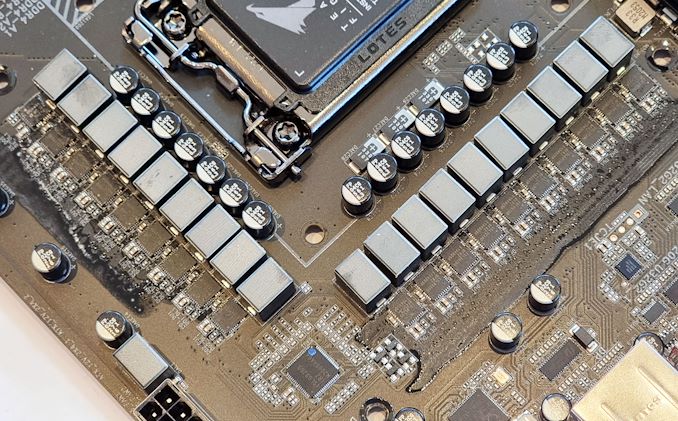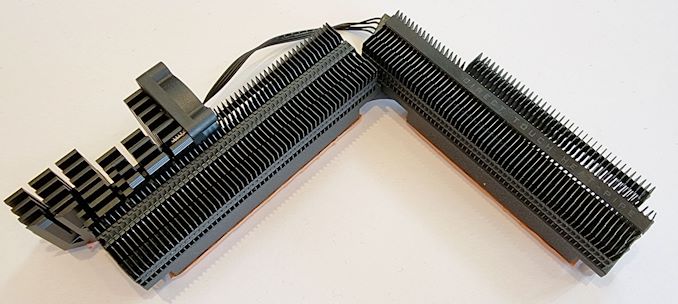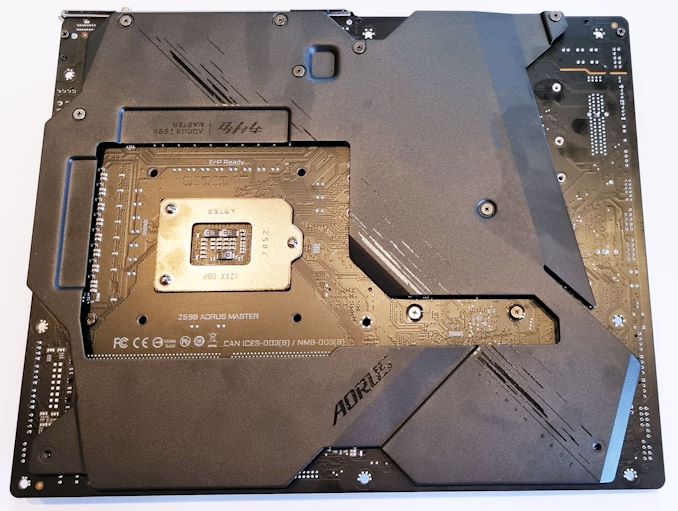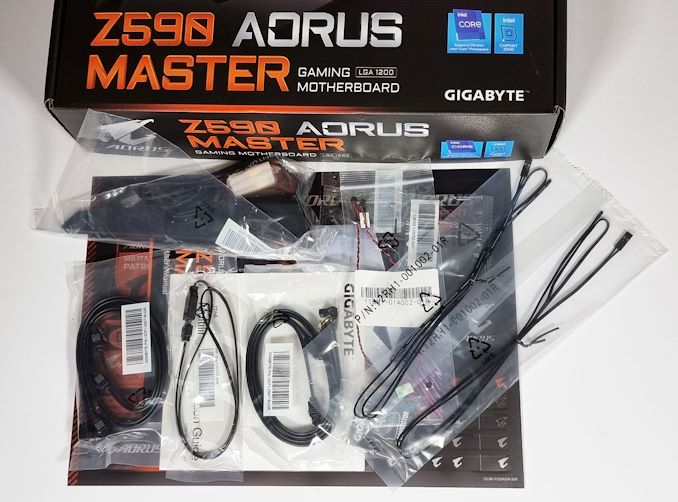GIGABYTE Z590 Aorus Master Review: Soaring High With Rocket Lake
by Gavin Bonshor on April 28, 2021 1:00 PM ESTVisual Inspection
If you were to compare the previous Aorus Master with the latest version we have here, you would be hard-pressed to find any real notable differences in regards to aesthetics. The GIGABYTE Z590 Aorus Master keeps the same black and silver aesthetic that has worked for the vendor for the last year or so. The Master has a typical Aorus design with a large rear panel cover including integrated RGB LEDs, PCIe slot armor, three M.2 heatsinks, and a large chipset heatsink which all mold into the overall design theme of the board.
Focusing on the lower portion of the board and protected by PCIe slot armor and metal reinforcement are three full-length PCIe slots. The top two slots feature support for PCIe 4.0 x16 and x8/x8, while the third slot is electronically locked down to PCIe 3.0 x4. Located above the top full-length PCIe 4.0 x16 slot is one PCIe 4.0 x4 M.2 slot, with one PCIe 3.0 x4/SATA slot located in the middle of the full-length slots, and another PCIe 3.0 x4/SATA M.2 slot located in between the bottom two full-length slots. This brings the total to three M.2 slots, with six SATA ports offering support for devices such as SATA-based HDDs and SSDs, as well as optical drives. The SATA ports also support RAID 0, 1, 5, and 10 arrays. None of the M.2 slots and the SATA ports share any bandwidth, which means all of the slots can be populated with SATA drives with no restrictions.
The GIGABYTE Z590 Aorus Master has plenty of integrated connectivity and front panel headers. Along the bottom is a pair of BIOS switches as the board features dual BIOS chips. In the top right-hand corner is a power and reset button pairing, as well as a two-digit LED debugger. Located around the edge of the board are eight 4-pin cooling headers, including one for a CPU fan, one for an optional CPU fan/water cooling fan, four for chassis fans, and a further four designed for system fans and water pumps. There is also a single USB 3.2 G2 Type-C header, two USB 3.2 G1 headers with support for an extra four Type-A ports, and two USB 2.0 headers which can also support four ports.
Located in the top-right hand corner of the board are a total of four memory slots. These slots can support DDR4-5400 memory, which is one of the highest speeds we've seen from a vendor's QVL lists for Z590 so far. It should be noted this level of memory frequency support relates to users planning to use Intel's 11th generation Rocket Lake processors. The four memory slots can accommodate up to 128 GB of capacity.
Looking at the power delivery, and the Z590 Aorus Master has a combined 19-phase power delivery which is configured into a (9*2)+1 design. The CPU section includes eighteen Intersil ISL99390 90 A power stages, which are doubled up by nine Intersil ISL6617A doublers, with a single Vishay SIC651 50 A power stage powering the board's SoC. This is an impressive power delivery for enthusiasts and overclockers alike, as the CPU section can deliver a maximum output of 1620 A to the processor. Controlling the power delivery is an Intersil ISL69269 PWM controller and is operating in a 9+1 (18+1) configuration.
Keeping the power delivery cool is a large two-section heatsink connected by a single heat pipe. This heatsink pairing uses multiple aluminum cooling fins to catch and direct airflow within a chassis, with plenty of mass in the main area of the heatsink. Attached to the end of the heatsink, which sits under the rear panel cover, is a small cooling fan that is designed to cool the Aquantia AQC107 10 GbE controller. Unfortunately, the way this is designed doesn't add any cooling properties to the power delivery itself.
On the rear of the board is a large metal backplate, which adds rigidity to the board and adds some cooling properties to the rear of the power delivery through the use of thermal pads. It stretches from the top of the board to the bottom, with cut-outs in the bottom and in the center around the socket area, to allow sufficient passive airflow to prevent choking the componentry out.
For on-board audio, the solution is driven by a Realtek ALC1220-VB HD audio codec, with an additional ESS Sabre ESS9118 DAC, which assisting the codec. This solution includes support for DTS:X Ultra, which is surround sound virtualization and is direct competition in both specification and quality to Dolby's solutions. Located on the audio section of the PCB are five Japanese Gold Nichicon audio capacitors, with four red WIMA audio capacitors, and the audio area includes PCB separation for less interference from the rest of the board's componentry. It is covered by a plastic cover for aesthetic purposes, although the HD audio codec doesn't include EMI shielding.
On the rear panel is plenty of connectivity, which is spearheaded by one USB 3.2 G2x2 Type-C, five USB 3.2 G2 Type-A, and four USB 3.2 G1 Type-A offering a lot of premium connectivity for the price. For networking, there's an Aquantia AQC107 10 GbE controller, with Intel's latest AX210 Wi-Fi 6E CNVi, which offers both 6 GHz band access and support for BT 5.2 devices. A single DisplayPort 1.2 video output allows users to use Intel's integrated UHD graphics, while five 3.5 mm audio jacks and S/PDIF optical output is powered by a Realtek ALC1220-VB HD audio codec and ESS Sabre ESS9118 DAC pairing. Finishing off the rear panel is a Q-Flash BIOS Flashback button and a Clear CMOS button.
What's in The Box
The accessories bundle includes four black SATA cables, an Intel AX210 Wi-Fi 6E antenna, a G-Connector, a large Aorus branded sticker sheet, a user manual, and a driver installation disc. GIGABYTE also includes a pair of thermistor cables for allowing users to monitor temperatures externally, which is typically a feature associated with enthusiast models.
- User manual
- Driver/Software installation disk
- Aorus sticker sheet
- Aorus case badge
- 4 x SATA cables
- 2 x Thermistor cables
- G-Connector
- RGB extension cable
- Intel AX210 Antenna
- Noise-detection cable


















39 Comments
View All Comments
Oxford Guy - Thursday, May 6, 2021 - link
'well just because they eliminated a warranty option may just mean no one was buying it'I'll buy that for a dollar.
JVC8bal - Wednesday, April 28, 2021 - link
Overall, I am happy with this product. DDR-4400, overclocked 11900k at 5.1ghz all cores, gen4 NVMe SSD, 3080 running 16x gen4.However, there was an issue that x570 PCIE gen4 users encountered, that they seem to be correcting. If you had a gen4 NVMe + gen4 graphics card, every 300ms you would get a WHEA-LOGGER event and the computer would BSOD every 1-2 hours. After many responsive emails from their customer support, BIOS version f5d now allows a NVMe gen4 + graphics gen4 without crashing. There is still a WHEA-LOGGER message every 300ms which is noise, but that should be fixed with a future Intel Chipset update.
skaurus - Thursday, April 29, 2021 - link
You talking about AMD chipset issue, but this motherboard is based on Intel chipset. Completely another story.JVC8bal - Friday, April 30, 2021 - link
Yet the issue was the same: an implementation problem of the PCIE 4.0 specs for first-generation platforms. But thank you for feeling it necessary to respond with the simplistic obviology.Spunjji - Thursday, April 29, 2021 - link
Given how none of that second paragraph was relevant to this article, you look suspiciously like you're repeating keywords to maintain the prevalence of specific, already-resolved issues pertaining to Intel's competitors in search-engine rankings. What a mess.JVC8bal - Friday, April 30, 2021 - link
Actually, after doing a RMA on 3 of these boards to find the problem, I felt inclined to respond to the review. Others might be having this same issue. They will just need to update to the latest BIOS to avoid crashes with that combination of hardware. I don't why people like you feel the need to respond with conspiracy theories.WaltC - Thursday, April 29, 2021 - link
Sorry, man--but I installed a PCIe4 5700XT into my x570 Aorus Master back in July 2019--about 21 months or so. And I've never--not even once--had any of the problems you allude to...;) It's been solid as a rock. Someone has badly misled you--it's just common old anti-AMD FUD. Very immature hogwash.JVC8bal - Friday, April 30, 2021 - link
Google "whea-logger and pcie 4". x570 was the first platform to experience this manifestation of the problems This was helpful in identifying the problem of specific gen4 NVMe drives conflicting with gen4 graphics cards. Speaking of immature, what a response... not just words, but the logic: somehow your 1-off, personal experience is indicative over broader reality? It's anti-AMD propaganda?TheinsanegamerN - Friday, April 30, 2021 - link
"I dont have a problem therefore the problem does not exist and anyone who says otherwise is immature, look how mature and sohpisticated i am! My farts smell like cinnamon!"silverblue - Friday, April 30, 2021 - link
Is that with all the necessary security patches applied? AMD processors are more secure than their Intel competitors right now. AMD also offered PCIe 4.0 for nearly two years before Intel got in on the act. Finally, AMD CPUs are simply more efficient.Three for the search engines to chew on.